MiniatureBuildings.co.uk : Exploring model buildings of all sizes and styles
- Page (top)
- Home
-
About
Us -
Recent
Articles -
Scales &
Uses - Modelling
-
All
Articles
Miniature Buildings
(top of page)
Home
Articles
- Miniature
Buildings - Home +
-
Recent
Blogs -
All
Articles
.
Miniature Buildings
Some thoughts on building models of all types and sizes
Some thoughts on building models of all types and sizes
Welcome. If you have not visited Minature Buildings before can I suggest you begin with my Aims and Scope article or at the Home Page. If you have visited before - welcome back. I hope this article is of interest to you.
Simon Williams
I was privileged recently to be able to interview Simon, a professional and talented modelmaker, about his work. I am very envious of him. He used to be a procurement manager for a furniture company but has now been able to turn his former hobby into a full time occupation. Not that I have the talent to do the same but it is surely every enthusiast's dream. For Simon it is going well but (as many others have learned to their cost) a love of an activity is not enough to make it a living; a realistic commercial approach is need as well. In my experience of business, the procurement function in a company seems a good background to provide this.
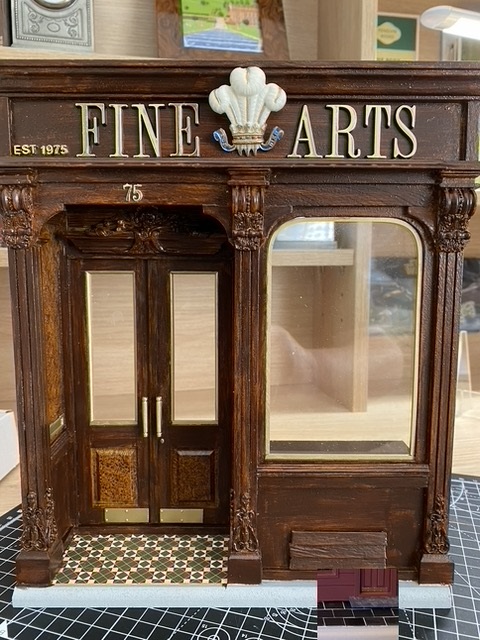
Fine Arts. An apt message.
Modelling that is more than just craft.
His speciality is ornate buildings. As can be seen in his website, simonwilliamsminiatures.com . This is not mass market stuff but bespoke work normally done on commission. A single piece can take two months to complete. We did not discuss prices but it is clear that work of this class does not come cheap. Before taking on such projects it is necessary to understand what the client is looking for and for the client to appreciate the cost implications of what they are asking for. As Simon says "it can be difficult to gauge the level of a client's commitment". Cost can be a limitation on what can be achieved.
There are some producers of this kind of work who focus on meticulous reproduction of a client's own house. If you like this sort of thing, and I certainly do, you might also like to look at my article on "house portraits". Although he has the skills to do this, Simon however brings something extra to the process. Although "miniatures should replicate something realistic" at least some of his work allows his imagination and creativity to produce something unique. Modelling allows you "to make something without limiting yourself".
Perhaps the defining charectaristic of Simon's work is the level and complexity of his ornamentation. Take another look at the first picture of the Fine Art shop. The corbels at the top of the pilasters, the Prince of Wales feathers forming the shop sign and the carving above the door. And in the part finished interior below, the decorative cornice and the fancy fireplace. With parts that detailed it is easy to miss that each panel has moulding - a simple detail that lots of lesser models miss. Simon is a real enthusiast for details acknowledging that "the devil is in the detail. Sometimes I don't know when to stop".
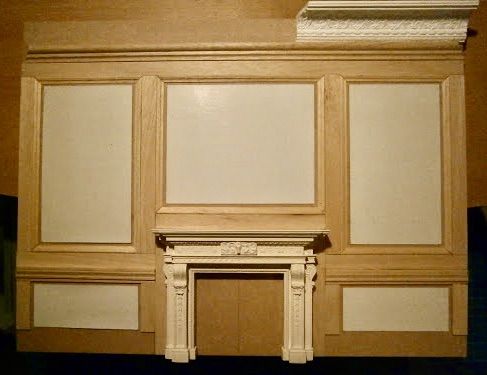
A rare opportunity to see a modeller's work in progress rather than just the finished article.
I was particulary interested in how he manages to achieve such complex work. The answer is a lot to do with being open minded. There are modellers who are committed to a single material. Wood, paper & card, plaster, metal ; all have their dedicated exponents. If you are a silversmith that seems understandable but I share Simon's view that most of us should use whatever works best in context. Sometimes that is wood, sometimes card or metal. 'Even' plastic. There is a widespread prejudice against the use of plastic but it has its place and it is often possible to have a fineness of detail in a plastic component that would not be possible with wood.
Simon is also a proponent of creating unique items from air drying clay. One of my recurring themes is that model builders should look across the different disciplines. Air drying clay is a staple of dolls house modelling but is commonly ignored by others. Just as styrene is commonplace for military modellers.
Another technique, increasingly a part of Simon's repetoire, is casting with resin using silicon moulds. He admits that he thought to begin wth that it might be too complex but has now made it part of his repetoire. He describes resin casts as "a useful trick to have" and says "there are infinite options of things to cast". Not necessarily bespoke masters of architectural details but everyday items or interesting little things made for a completely different purpose. One example was sections of small metal picture frames.
One of his imaginative ideas, used to great effect, is to cast details from military buttons or badges picked up from e-bay or other second-hand sources. I know, from my own experience, that antique stalls will often have a box of 'oddments' containing such things. The coat of arms shown below is a fantastic example of what can be done, and I suspect the Prince of Wales feathers illustrated earlier have a similar origin.
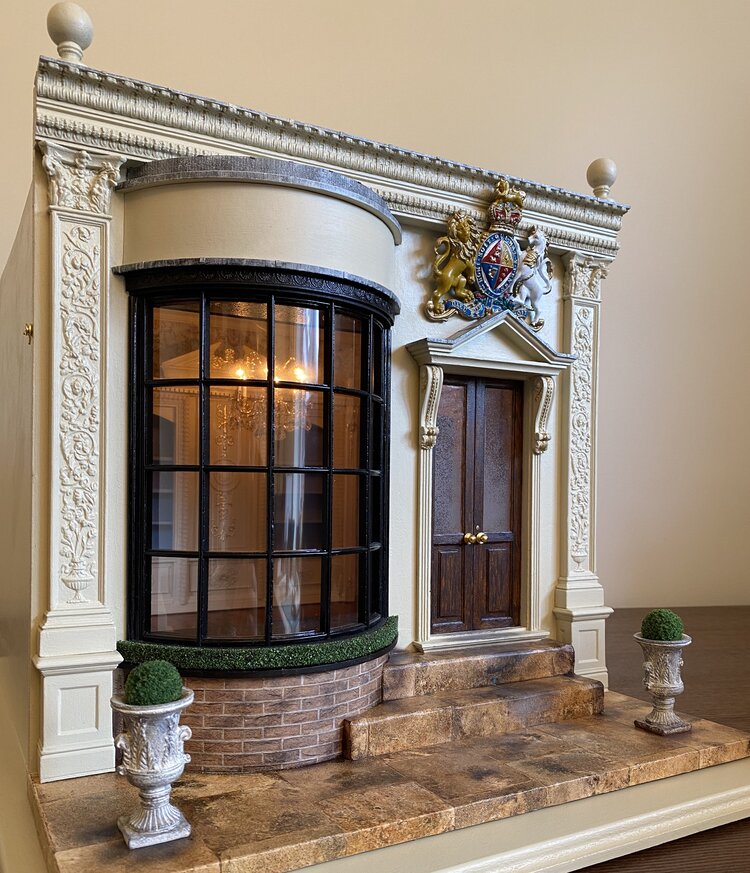
This picture also illustrates a couple of other features of Simon's work. The first is the wooden doors and the marble steps & forecourt. Wood is a key construction material for modellers but, even at 1/12th scale which is what Simon works at, the grain in real wood is almost always out of scale. There are certainly some model crafsman who produce exquisite work using finely grained wood. Someday I will take a fuller look at some of the furniture they produce but that is a bit outside the core interest of Miniature Buildings. Simon's approach is to produce a painted "faux" finish. Something I commend and discuss further in an article on scale or effect.
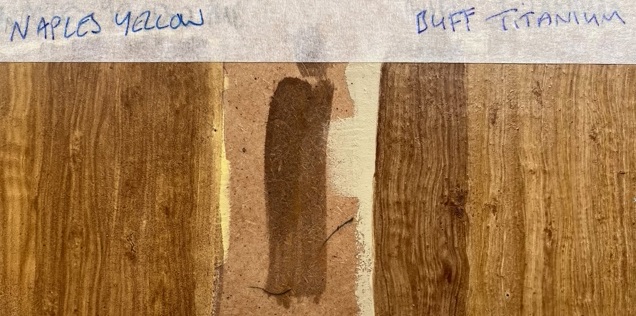 A test piece. It looks to me as if these various wooden sections are all created on a piece of MDF!
A test piece. It looks to me as if these various wooden sections are all created on a piece of MDF!
The same technique is used to create marble or other stones. Do not turn your nose up at faux marble. It has a noble heritage. Barbara and I recently visited two of the extraordinary palaces and castles of the mad Bavarain King Ludwig II. The second of these was a 19th century recreation of/homage to Versailles. The grand staircase is faced entirely in faux marble of many varying styles and colours. Our guide explained that this was done because it would have been too hard to create the desired effect using the real thing. But don't think was some pfenig pinching thing. Apparently the cost of getting craftsmen to produce the faux finish was higher than it would have been to buy the real thing.
 Simon produces interiors as well as exteriors. His work is the structure which he, or his customers can then 'dress' with furniture and 'objets' of their choice.
Simon produces interiors as well as exteriors. His work is the structure which he, or his customers can then 'dress' with furniture and 'objets' of their choice.
As well as illustrating the effectiveness of faux marble on the columns this picture also hints at Simon's modelling roots. Many modellers of buildings began life as railway modellers but discovered that the background buildings were interesting than the trains. Others began with a dolls house but decided the shell was more to their taste than the contents. Personally I started with Military figures but migrated to buildings later in life.
Simon is a rare example of someone who began with miniature theatres, an enthusiasm fuelled by the magical world of Pollocks Miniature theaters in Covent Garden. As anyone who has ever worked backstage or been involved in set building, like me, the concept of theatrical artifice translates well to making miniature buildings. What you see is not representative of what is underneath. Simon's sense of theatre is very evident in much of his work. It doesnt matter what the substrate is, it is the finish that matters for the audience/viewer.
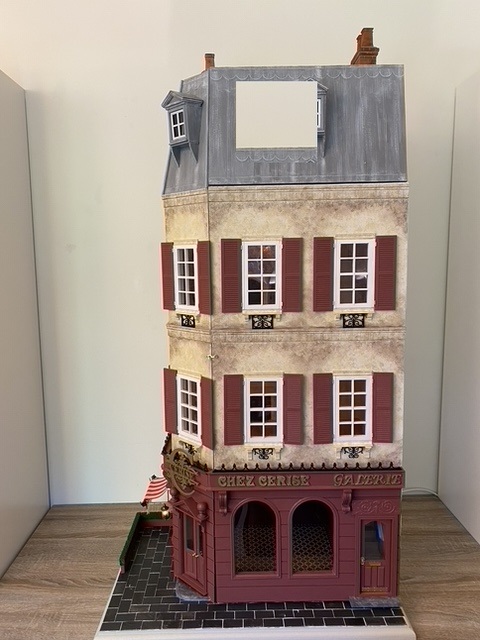
 Another example of Simon's work, this time of a French prototype.
Another example of Simon's work, this time of a French prototype.
There is a cautionary tale attached to this piece. A four storey model in 1/12 scale is a substantial item. Especially when the client wants it delivered to the fourth floor of their house!

Most of the ornamental work on his models is Simon's own work but he did acknowledge that some is bought in as components and he gave particular mention to Sue Cook. If you have never looked at her range of components it is maybe time you did.
I first noticed Simon's work through an interview he did for Dolls House and Miniature Scene magazine. Thank you to them for introducing me to him. More of his work can be seen on his own website, simonwilliamsminiatures.com or on Instagram.
As always, please
e-mail
Miniature Buildings
if you have something to add. Comments, criticisms,
extra thoughts, pictures, or even complete articles
for inclusion in the Miniature Buildings site
are all welcome. Or if you would like to be added to
my mailing list to hear when a new article is published.
David, October 2021